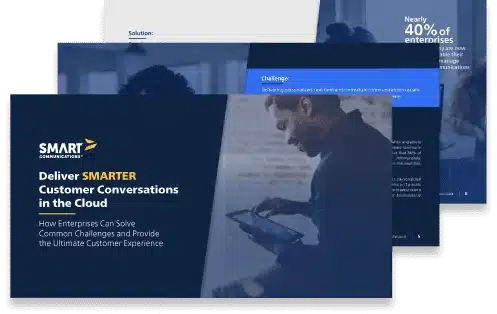3 Ways a Better Digital Forms Experience Helps Health Payers Increase Star Ratings
By: John Zimmerer, Vice President of Healthcare Marketing at Smart Communications
Star Ratings are a critical aspect for customers when evaluating health insurance plans as they help consumers make informed decisions about their health coverage. To increase enrollments, insurers should strive to keep their Star Rating above a 4.0, but they also need to think about the existing customers they serve. That means enhancing the overall customer experience and increasing customer loyalty, sometimes a tough ask with constantly shifting regulations and the need to accelerate digital transformation weighing on organizations.
In this article, we talk about how insurers can increase their Star Ratings by focusing on one of the top contributors to the overall customer experience: communications. To provide excellent communications across all channels where members interact with the business, health insurers need to help members feel seen and known as individuals. This starts with developing a strong customer communications strategy, made possible by leveraging pure cloud CCM solutions. As part of that communications strategy, insurers also need the proper forms solutions to gather member data and put it into action while ensuring they’re compliant and secure. Keep reading to learn the three ways a better digital forms experience helps to increase Star Ratings and customer loyalty, but first, we’ll touch on why Star Ratings matter.
Why are Star Ratings Important for Health Insurers?
- Measures quality of care: Based on various factors—such as preventive care, patient experience and medical outcomes—Star Ratings give consumers a comprehensive picture of the plan’s performance. This information can help consumers choose the best plan for their needs and ensure they receive quality care.
- Promotes competition: Star Ratings create competition among health insurance providers, encouraging them to improve their services and invest in the systems and processes that help them support their members. As a result, members benefit from a wider range of high-quality options and can choose the plan that best fits their needs.
- Improves transparency: The ratings provide a clear, unbiased assessment of the quality of benefits and services offered by health insurance plans, which can help consumers compare plans and make better-informed decisions about their health coverage.
- Supports evidence-based decision making: Star Ratings are based on data, including patient surveys and medical records, which helps to ensure that the ratings are accurate and factual. This data-driven approach supports evidence-based decision making and helps consumers choose the best plan for their needs, an especially important factor considering the growing digital native cohort who’ve become accustomed to making decisions quickly.
YOU MIGHT ALSO LIKE | ‘4 Ways Forms Automation Can Enhance the Healthcare Member Experience‘
1. Digital Forms Can Help Address This Customer Driver Behind CX and Loyalty
As of 2023, Star Ratings have become more impacted by customer experience (CX) with member experience metrics making up 57% of Star Ratings for Medicare Advantage plans. Considering 1 in 3 customers will leave a brand they love after just one bad experience, it’s critical to avoid situations that can lead to this. With that said, effective customer communications management is key to providing a positive customer experience. Health insurers should aim to provide clear and concise information about their plans, including claim-related communications. The requirement to provide personalized communications, tailored to the individual member’s needs, also extends to forms processes.
For example, claims appeals can become tricky when using traditional methods of communicating between a member and the payer. When questions arise, members are typically instructed to contact a call center and find, fill out and submit a generic appeal form to request redetermination. This multi-step approach increases the customer effort (another factor that impacts Star Ratings) and ultimately leads to frustration. However, this form is an important piece of information during the redetermination process and can’t be overlooked.
Using a digital forms solution, on the other hand, allows members to engage in an intelligent interview that provides a guided experience. A link to the interview can be embedded directly into the Explanation of Benefits (EOB). After submitting their responses to the interview, members can download a copy of the appeal form for their records. By integrating the interview with core systems, an Appeals and Grievances staff member can be notified of the submission and start the review process. This allows insurers to provide members with a self-service option and save time and money by removing steps related to receiving, scanning and routing paper forms.
2. Build Loyalty by Helping Customers Understand Their Plans
Health insurance can be a confusing and complicated topic for many consumers. With many different plans and options available, it can be difficult to understand exactly what is covered under a particular policy and what out-of-pocket costs might be incurred. However, health insurers can build loyalty by helping their customers understand their health plans and making the process of navigating the healthcare system easier.
One way to do so is by providing clear and concise information about the different aspects of a health plan. This might include easy-to-understand descriptions of coverage options, deductibles, copays and other terms that are commonly used in the healthcare industry. By providing this information in a format that is easy to understand, payers can help customers feel more confident in their decision-making and more comfortable with the choices they have made. This enhances the overall member experience, thus, increasing loyalty and customer retention.
In addition to providing clear information about the details of a health plan, health insurers can also help their customers understand the broader healthcare system. For example, they can offer resources and tools that explain how to find a doctor, how to schedule appointments and how to access other benefits. By offering this type of support, customers will feel more empowered and in control of their healthcare experience, including having more options to easily self-serve when necessary.
Offering personalized support and guidance will require the right systems and processes in place, like SmartIQ, a sophisticated digital forms solution. Providing this type of personalization, health insurers ensure customers feel heard and valued, and can establish a deeper connection with their members. Straightforward information about the costs of healthcare services, and clear explanations about any restrictions or limits on coverage, will help build trust and establish a strong relationship with their customers.
RELATED READING | ‘Work SMARTER, Not Harder: Enhancing CCM Efforts with Forms Automation‘
3. Create a User-Friendly, Digital Forms Experience
The member’s experience with forms is measured by the CAHPS surveys and translates to the customer service metric in the Stars Rating. When providing interacting with a health-related form, everything from which colors are used to font sizes and the information architecture influence a member’s perception of the brand. All are also key factors in creating user-friendly forms experience. But, how do health insurers know what to look for when creating responsive and user-friendly digital forms that elicit a positive response from members? The good news is, a pure cloud forms solution enables organizations to create a truly responsive forms experience, meaning it will look and operate the same across all platforms and channels. A few things to keep in mind:
- Use what you know. Leverage integrations with core systems and single sign-on to pull data into forms so that members can review and revise rather than rekey this information. This will reduce the member’s effort as well as the opportunity for data entry errors.
- Make the form visually appealing. Use a clean and organized layout, including clear headings/subheadings, helping customers quickly find the information they need. Consider using colors and images to make the form more appealing and easier to navigate.
- Keep it simple and straightforward. Avoid using technical terms/jargon that may be confusing or misleading to customers. If specific terminology must be used, be sure to provide clear explanations of any terms that may be unfamiliar to customers. This includes using help text in the form.
- Make the form accessible. Ensure all digital forms are accessible to customers with disabilities; this isn’t simply a nice-to-have, it’s a must-have, given 508 compliance mandates. Use appropriate formatting, like larger text/high-contrast colors, and include alternative text descriptions for images. We offer a guide to help make SmartIQ interviews WCAG-compliant.
- Validate information in real-time. Use real-time validation to alert customers of any errors or missing information as they complete the form. This helps reduce the risk of errors and ensure that the form is completed correctly the first time, diminishing the chance for customer frustration and/or eliminate delays.
The above list is not exhaustive by any means but it’s important not to overlook this key point to enhancing star ratings and customer loyalty. In fact, 60% of customers will abandon a form if the process is too difficult—something that could be mitigated by deploying modern forms that are easy to engage with. The right vendor partnership will help insurers optimize the systems and processes they use to interact with customers, including the user-friendliness of their forms experiences.



